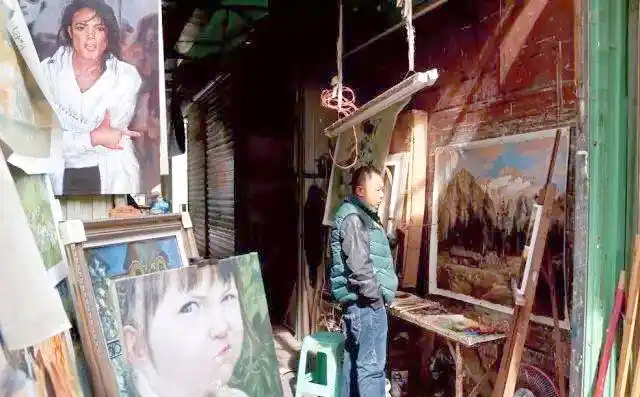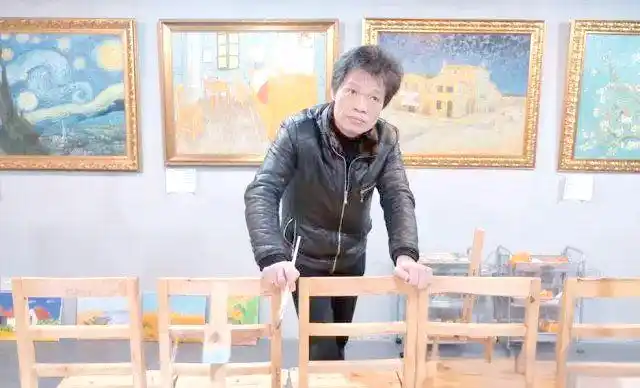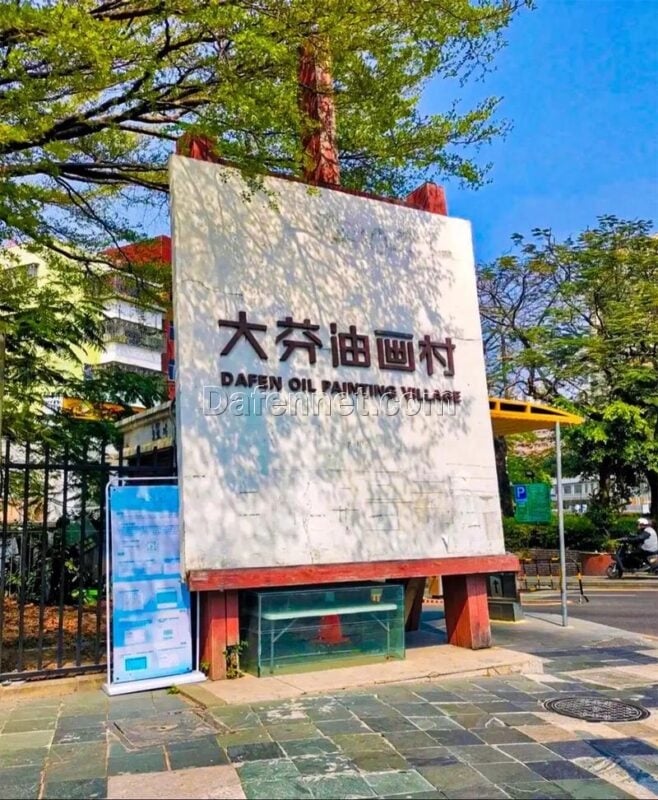Dafen oil painting Village
The Current Situation and History of Dafen Village Oil Paintings
Tourists in Amsterdam and Painters in Dafen Village
Every weekend, the Van Gogh Museum in Amsterdam welcomes numerous tourists. Built with glass and concrete, the museum shimmers with colorful lights at night, resembling Van Gogh’s oil painting world. After admiring over 200 original Van Gogh works, visitors walk out of the museum. Some enter nearby souvenir shops, carefully appreciating replicas of Van Gogh’s oil paintings and negotiating prices with shopkeeper Gerard.
However, these tourists in Amsterdam may not know that in a small village in Shenzhen, China, painters in Dafen Village are busy creating classic works such as The Starry Night, Sunflowers, and Self-Portrait. These “Made-in-China” oil paintings will travel by plane, ship, and other means of transportation for days or even months, eventually reaching Van Gogh’s hometown and becoming sought-after collectibles.
Overview and Changes of Dafen Village

Dafen Village is only 3 kilometers away from Buji Town, Shenzhen, surrounded by two main roads with numerous shops, restaurants, and hostels nearby. A giant stone painting board at the village entrance is inscribed with “Dafen Oil Painting Village”, and a sculpture holding a paintbrush beside it looks solemn and dignified. Inside the village, besides three narrow streets, there are crisscrossing alleys, with painting studios and galleries everywhere. Wandering through the streets and alleys, one can tour the entire village in half an hour.
Zhao Xiaoyong and the Early History of Dafen Village

When Zhao Xiaoyong first came here, Dafen Village had only one small workshop. Today, it has developed into a world-famous oil painting industry base. At the end of 1996, Zhao Xiaoyong was painting in his dormitory in his spare time when a fellow villager accidentally saw his work and praised its exquisiteness. The fellow villager revealed that his elder brother made a living by painting in the distant Dafen Village, which opened Zhao Xiaoyong’s eyes. A few days later, the fellow villager invited him to visit Dafen Village.
Zhao Xiaoyong witnessed the entire process of oil painting creation for the first time. The painters painted freely with amazing speed and beautiful works, which deeply impressed him. After returning to the factory, he told the fellow villager his wish to go to Dafen Village to learn painting. The fellow villager reminded him that painting is an art that requires time and refinement, and it may take half a year or even longer to master basic skills.
Zhao Xiaoyong has had a strong interest in painting since childhood. Born into a rural family in Shaoyang, Hunan, he is the third of four brothers. His father was a warehouse manager in a machinery factory and passed away due to illness when he was in junior high school. Later, his eldest brother took over his father’s job. His second brother, an artist skilled in fine brushwork painting and calligraphy, would practice painting and calligraphy at home every night, depicting all 108 heroes of the Water Margin in an album. Sitting beside his second brother watching him paint since childhood, Zhao Xiaoyong’s love for painting grew day by day. Later, when his second brother went to work in Shenzhen, Zhao Xiaoyong practiced sketching and gouache painting hard at home, trying to depict flowers, plants, and figures.
In August 1997, Zhao Xiaoyong resigned from his original job with several fellow villagers and came to Dafen Village. At that time, there was only one oil painting factory opened by Hong Kong art dealer Huang Jiang and hundreds of painters here. Initially, Zhao Xiaoyong rented a house with Zhang Zhengjing, the elder brother of his fellow villager, and learned oil painting skills from him. Zhang Zhengjing had been engaged in commercial oil painting production in Shenzhen for ten years. He was responsible for taking orders from Huang Jiang, painting at home, and delivering them regularly.
In the early stage of learning, Zhao Xiaoyong was full of enthusiasm for painting and tried various types of works. However, as time went by, he found it difficult to find a clear position and made slow progress. In less than two months, he began to waver and even had the idea of giving up. At this time, Zhang Zhengjing suggested that he try painting Van Gogh’s works. Due to the high demand for Van Gogh’s paintings, Zhang Zhengjing could not complete all the orders alone, so he decided to assign some orders to Zhao Xiaoyong to help him earn living expenses and rent.
Under Zhang Zhengjing’s guidance, Zhao Xiaoyong began painting Van Gogh’s works. After two or three months of hard practice, he gradually mastered the painting skills and decided to become independent. He rented a single room in Dafen Village with a monthly rent of only 300 yuan and started his own painting career. However, at first, he repeatedly hit a wall when seeking orders from Huang Jiang. Huang Jiang pointed out that his level had not yet met the standard for delivery.
Faced with difficulties, Zhao Xiaoyong did not give up. He practiced hard behind closed doors every day, focusing on copying Van Gogh’s works. He found that Sunflowers and The Café Terrace on the Place du Forum, Arles, at Night were the most popular, so he concentrated on painting these two works. After completing two or three works a week, he would carry them to galleries in the urban area to try to sell them. During this period, his second brother once suggested that he open a stationery store, but he believed he loved painting and decided to persist, whether he could make money or not. He maintained confidence and continued to work hard on the road of painting.
Huang Jiang’s Entrepreneurship Journey

In 1987, Huang Jiang co-founded an oil painting factory with a friend in Huangbeiling, Luohu District. They took oil painting orders from Hong Kong and attracted a large number of painters, totaling more than 60 people, who copied world-famous paintings together in this spacious 600-square-meter factory building. At that time in China, such a scale was quite considerable. However, two years later, due to the soaring surrounding land prices, the landlord raised the monthly rent sharply from the original 2,000 yuan to more than 6,000 yuan. At the same time, his partner gradually strengthened the management of the factory, which Huang Jiang could not stand, and finally decided to start his own business.
Huang Jiang looked for a suitable place to settle in Buji Town outside the special zone. He hoped the rent would be cheap and the painters could be free from external interference. When he accidentally came to Dafen Village, this quiet village immediately attracted him. A small river flowed through the village, with farmland and low bungalows set against each other, and yellow chickens and ducks wandered freely in the alleys. Huang Jiang thought this place was like an isolated sacred place for painting.
The Development of Dafen Village and External Influences
With the continuous rise of Huang Jiang’s fame, the number of painters in Dafen Village also increased day by day. Many painting enthusiasts and art college graduates came one after another, hoping to get orders from Huang Jiang. Most of them chose to rent houses in the village, enjoying low rent and a free creative environment. This order subcontracting model gradually became Huang Jiang’s core business. He no longer painted personally, but focused on management and business expansion.
By the mid-1990s, hundreds of painters had gathered in Dafen Village. Guo Rong (pseudonym), a native of Fujian, saw the business opportunity and began to open shops in the village, selling necessary supplies such as paintbrushes, canvases, and paints. With the gathering of painters and low rent, more art dealers scattered in Shenzhen gradually moved into Dafen Village, further promoting the development of the industry.
Zhao Xiaoyong’s Development and Reflections in Dafen Village
In 2016, Zhao Xiaoyong opened a new gallery in Ningbo, covering an area of more than 90 square meters, aiming to realize his dream of creating original paintings and high-quality Van Gogh-style copies. After returning from his trip to the Netherlands, he actively devoted himself to creating original paintings and completed a total of five works, including Self-Portrait and landscape paintings of his hometown. These works are deeply influenced by Van Gogh, showing not only Van Gogh’s unique style but also integrating Zhao Xiaoyong’s personal creativity and emotions. Several of these works have been successfully sold at an average price of more than 5,000 yuan.
In an interview, Zhao Xiaoyong frankly said that his original paintings have the shadow of Van Gogh, aiming to take Van Gogh’s artistic style as the cornerstone and integrate his own unique insights and emotions. He hopes to create original works that not only retain Van Gogh’s charm but also have personal characteristics through this way. At the same time, Zhao Xiaoyong also said that he has always cherished the dream of becoming a painter and will make unremitting efforts for it, enjoying the fun and challenges of artistic creation.

